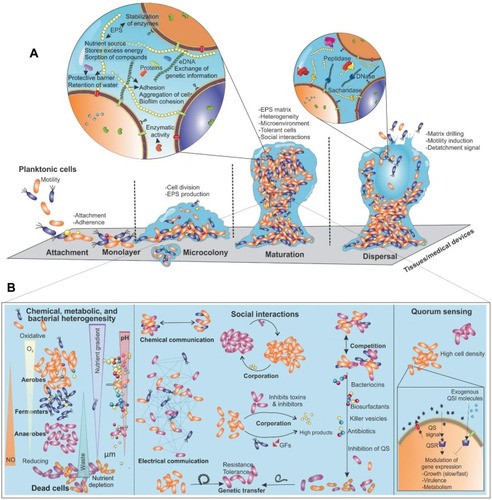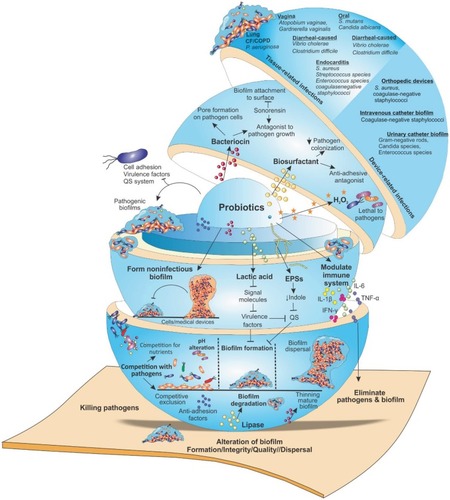Figures & data
Table 1 Activity of Probiotics Against Oral Biofilms
Table 2 Activity of Probiotics and Their Products Against Biofilms
Figure 1 The stages and complex structure of bacterial biofilms. (A) Different stages are involved in biofilm formation, during which a series of changes happen. These stages include initial attachment, microcolony formation, maturation and dispersion. Detachment allows bacteria to colonize in new niches. (B) The formation of the EPS matrix leads to the establishment of stable gradients of nutrition, pH, waste products and oxygen that make different localized habitats at a small scale. Social connections in biofilms include positive (competition or cooperation) and negative (competition) interactions between bacterial cells that result in remodeling of the biofilm community. Cooperation is mediated by electrical and chemical communications between cells in biofilms while competition is mediated by different killing strategies such as producing bacteriocins, antibiotics, enzymes and growth inhibition mechanisms like preventing QS and depletion of nutrient.
Abbreviations: EPS, extracellular polymeric substance; GFs, growth factors; NO, nitric oxide; QS, quorum sensing.

Figure 2 Targeting microbial biofilms by probiotics. Probiotics employ different mechanisms by which interfere with the activity of pathogenic bacteria. They produce antagonistic substances such as, surfactants, bacteriocins, EPS, organic acids, lactic acid, fatty acids, enzymes (lipase, amylase) and hydrogen peroxide that can hinder the activity of pathogenic bacteria and their adhesion to surfaces. Moreover, they prevent QS, biofilm formation and the survival of pathogens as well as interfere with biofilm integrity/quality, finally, lead to biofilm eradication. Furthermore, probiotics generate unfavorable environmental conditions for pathogens (e.g., pH alteration as well as competition for surface and nutrients). Their competitive adhesion to human tissues or medical devices (catheters, prostheses, or other medical devices), prevent the colonization of harmful bacteria. Additionally, by modulating host immune responses and formation of non-pathogenic biofilms, they target pathogenic biofilms that prevent the biofilms formation by certain pathogenic bacteria.
Abbreviations: CF, cystic fibrosis; COPD, chronic obstructive pulmonary disease; EPS, extracellular polymeric substance; QS, quorum sensing; UTI, urinary tract infection.

